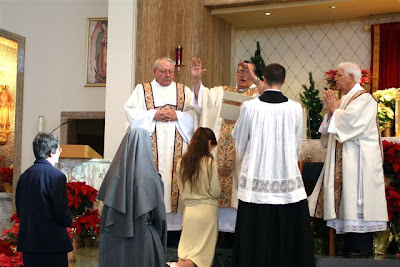 I stumbled on this blog the other day: Sponsa Christi, which contains reflections from a newly consecrated virgin, a 23-year-old young woman who hopes to pursue a career in theology or canon law. (Above is a picture from her rite of consecration — complete with deacons! — earlier this month.)
I stumbled on this blog the other day: Sponsa Christi, which contains reflections from a newly consecrated virgin, a 23-year-old young woman who hopes to pursue a career in theology or canon law. (Above is a picture from her rite of consecration — complete with deacons! — earlier this month.)
Surf around the site and you’ll find fascinating stuff about this unusual (and often misunderstood) calling, plus an account of her own vocation story. There’s also this clear and concise description:
Modern consecrated virgins are solemnly consecrated by the local diocesan bishop (or by a delegated auxiliary bishop) within the context of the revised rite. The bishop is the one who grants permission for women to receive this consecration, as well as the one who determines the concrete circumstances under which they are to live their consecrated lives. Consecrated virgins remain directly under his authority, unlike religious sisters who are ordinarily accountable to the superiors of their religious community.
Besides life-long celibacy, the only formal obligation of a consecrated virgin is prayer, especially for the people, clergy, and bishop of her diocese. During the Rite of Consecration a consecrated virgin is also given the responsibility to pray the Liturgy of the Hours, the official prayer of the Church.
While consecrated virgins are expected to live simply, they do not take vows of poverty and must support themselves financially. Because of this, they are not required to take on any specific ministry. However, they are still called to be “dedicated to the service of God and the Church.”
Consecrated virgins exist in the Church today for the same reason that consecrated people have always existed—to be a living sign and witness of the love Christ has for His people.
Congratulations and prayerful good wishes to “Sponsa Christi”!

